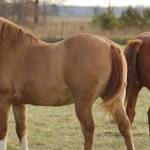Beyond Body Condition: Assessing Your Horse’s “Keeper Status”

Surveys show that horse owners routinely underestimate the body weight of their horses, believing they are thinner than they are. A new study found that owners find it equally challenging to assess their horse’s “keeper status,” which ultimately affects the way their horses should be fed and exercised.*
What is keeper status? Simply put, it’s a description of a horse’s metabolic status. Horsemen have likely heard of easy keepers and hard keepers (also called “good doers” and “poor doers” in some regions). Horses that can maintain reasonable body condition on little feed or forage are considered easy keepers, while horses that have difficulty maintaining weight on normal, or even higher than normal, amounts of feed and forage are known as hard keepers.
Unless they’re extremely obese, overweight horses tend not to raise eyebrows. Thin horses, on the other hand, are scrutinized by horsemen and laymen alike, and their owners are often judged for the quality of care offered.
In an effort to alter a horse’s appearance, owners sometimes make drastic dietary changes. For easy keepers, modifications may include caloric restriction resulting in diets devoid of essential nutrients, such as vitamins and minerals. For hard keepers, owners may overfeed or offer too many energy-dense feedstuffs.
Recently, researchers developed a novel equine keeper status scale (EKSS) to objectively assess a horse’s true keeper status. This mathematical equation includes the horse’s body condition score (BCS) as well as the digestible energy in the diet based on the horse’s estimated digestible energy requirements to achieve moderate body condition, a score of 5.
After applying the EKSS to a population of 240 horses and ponies of various breeds, ages, and sexes, researchers found that 35% of all animals were classified as easy keepers with 25% and 45% deemed “medium” and hard keepers, respectively.
“Conversely, most owners (60%) were not able to accurately assess their horse’s keeper status. Instead, owners reported that 45% were easy keepers, 32% were medium keepers, and only 23% were hard keepers,” said Kathleen Crandell, Ph.D., a Kentucky Equine Research nutritionist.
Having an accurate assessment of a horse’s keeper status, in addition to its BCS, will allow owners to formulate more appropriate and nutritionally sound diets.
“Owners will be most successful at designing optimal nutrition plans for their horses based on BCS and keeper status if they work with an equine nutritionist, use online calculators to determine digestible energy, and consider having their feeds and forages analyzed. Knowing a horse’s keeper status will help the horse owner, veterinarian or professional make informed energy management decisions for the horse,” advised Crandell.
In addition to not meeting the nutritional needs of easy and hard keepers, diets that stray too far from nature may result in alterations of the intestinal microbiome.
“Extremes in energy intake, from restriction to overabundance, can have adverse effects on the resident microbial population in the digestive tract, affecting the health and well-being of the horse,” she said. “A robust intestinal microbiome will not only influence the ability of the horse to derive energy and nutrients from the diet but also help to maintain healthy gastrointestinal and immune systems.”
In addition to appropriately matching diet to keeper status, hindgut buffers support a healthy cecal and colonic environment, which are characterized by a stable pH and a rich, diverse microbiome. Offer a hindgut buffer while adjusting your horse’s diet and for a minimum of three weeks after a consistent diet has been achieved.
*Johnson, A.C.B., and A.S. Biddle. 2021. A standard scale to measure equine keeper status and the effect of metabolic tendency on gut microbiome structure. Animals (Basel):11(7):1975.








